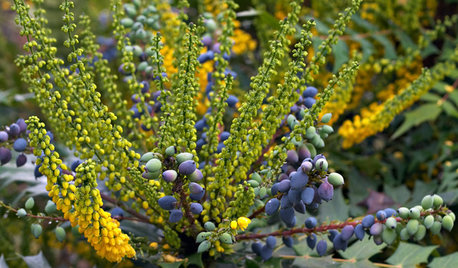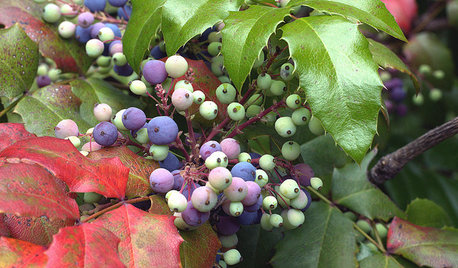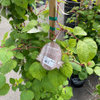was I wrong to purchase some compact oregon grape holly
katrina1
16 years ago
Related Stories

GARDENING FOR BUTTERFLIESGreat Design Plant: 'Charity' Oregon Grape
Giving nectar to hummingbirds and delicious berries to all, 'Charity' is a four-season garden delight that lives up to its name
Full Story
MY HOUZZMy Houzz: Pursuing Their Life’s Work in Rural Oregon
This creative couple craft a live-work world all their own in the high country of eastern Oregon
Full Story
GARDENING GUIDESGreat Design Plant: Mahonia Aquifolium for Birds
Oregon grape puts on a bold spectacle from spring through winter and is ideal to brighten partly shady corners in the U.S. West
Full Story
GARDENING GUIDES8 Deer-Resistant Elegant Evergreen Shrubs to Plant This Fall
Who knew that such beautiful shrubs could be deer-resistant?
Full Story
HOUZZ TOURSMy Houzz: Wasting Not, Wanting Not in a New Portland House
Salvaged and secondhand elements make for a home that's earth conscious, thrifty and beautifully personal
Full Story
BOOKSCan Tidying Up Result in Life-Changing Magic?
Organizing phenom Marie Kondo promises big results — if you embrace enormous changes and tough choices
Full Story
SMALL SPACESLife Lessons From 10 Years of Living in 84 Square Feet
Dee Williams was looking for a richer life. She found it by moving into a very tiny house
Full Story
SMALL HOMES28 Great Homes Smaller Than 1,000 Square Feet
See how the right layout, furniture and mind-set can lead to comfortable living in any size of home
Full Story
TINY HOUSESHouzz TV: Step Inside One Woman’s 140-Square-Foot Dream Home
You may have seen the story on Houzz — now check out the video tour of Vina Lustado’s warm and welcoming tiny house
Full Story
CRAFTSMAN DESIGNHouzz Tour: Bridging Past and Present in a California Craftsman
A Santa Monica bungalow says goodbye to gloominess and hello to a bright new look that mixes modern and traditional
Full StoryMore Discussions








rhizo_1 (North AL) zone 7
gardengal48 (PNW Z8/9)
Related Professionals
Oconomowoc Landscape Architects & Landscape Designers · Salisbury Landscape Architects & Landscape Designers · Arlington Landscape Contractors · Bethel Park Landscape Contractors · Lynwood Landscape Contractors · Natick Landscape Contractors · Riverview Landscape Contractors · Seminole Window Contractors · Surfside Window Contractors · Crowley Driveway Installation & Maintenance · Cincinnati Driveway Installation & Maintenance · New Bedford Driveway Installation & Maintenance · Randolph Driveway Installation & Maintenance · Fort Collins Decks, Patios & Outdoor Enclosures · Palmetto Decks, Patios & Outdoor EnclosuresIris GW
gardengal48 (PNW Z8/9)
Iris GW
katrina1Original Author
gardengal48 (PNW Z8/9)
katrina1Original Author
flora_uk
katrina1Original Author
gardengal48 (PNW Z8/9)
flora_uk
OKMoreh
Embothrium
garden4510
edlincoln
morz8 - Washington Coast
gardengal48 (PNW Z8/9)
edlincoln
jimbobfeeny
flora_uk